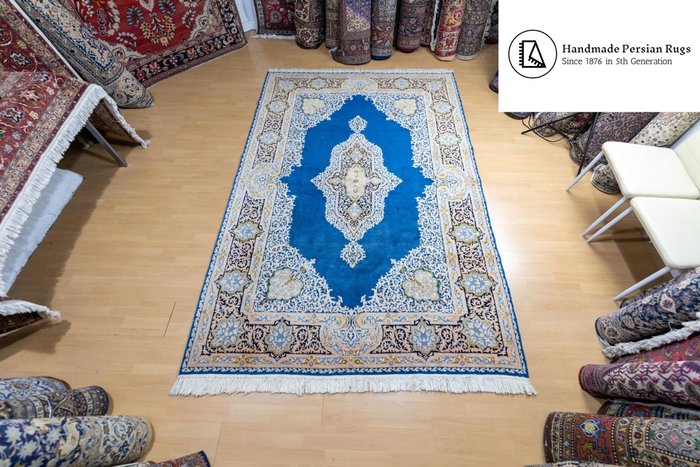Nº 81463749

Kirman - Tapis - 272 cm - 182 cm
Nº 81463749

Kirman - Tapis - 272 cm - 182 cm
Origin: Iran Kirman (also Kerman)
Knot density: approx. 360.000 knots/sqm (42 radj)
Condition: New
Pattern: Ghab Ghorani with Medallion
Material: pile 100% virgin wool - warp 100% cotton
Kerman or Kirman teppich
Kerman carpets (sometimes “Kirman”) are one of the traditional classifications of Persian carpets. Kerman is both a city and a province in south-central Iran, although the term sometimes describes a type that may have been made elsewhere. Kerman rugs are valued for their great variety of patterns, wide range, use of natural dyes and fibers, high tensile and abrasion resistance, and expert color combinations. Typical manufacture uses an asymmetrical knot on a cotton base, but rare examples may also include silk or part-silk hair, or silk bases with wool hair.
Designs and patterns from the Kerman region
Due to the enormous demand for the rugs produced in Kerman and the complex demographics of that demand, a surprising variety of styles and patterns were produced. Some Kerman rugs were woven specifically for wealthy Western buyers, others for local consumers with diverse tastes.
The Damask rose is the most popular motif in Kerman carpets, particularly in the “Sabzikar Ravar” and “Gol Sorkhi” (Red Rose) carpets. Other well-known patterns are “Ghab Ghora'ani”, “Setooni”, “Ghabi”, “Kheshti”, “Saraam Atiyeh”, “Jangali”, “Shekargah” and “Lachak-Toranj”. The border of the Toranj pattern, which consists of narrow borders and lines, is often used in old carpets from Kerman. The floral patterns woven in Kerman rugs in the 19th century descended from the patterns on Kerman shawls, which were also made in Kerman at the time.
A distinct variant of the Kerman carpets is the Lavar or Ravar Kerman. Made in the village of Ravar, near the town of Kerman in the Northern Region, these rugs are best known for their fine weave and elegant, classically inspired patterns in an all-over central medallion style. Most Ceramic Ravar or Lavar rugs bear a signature, either that of the weaver or that of the person for whom the rug was woven.
Old Persian carpet from Kerman
A typical 16th- and 17th-century Kerman rug, vase rugs feature a relief design of stylized flowers and oversized palmettes, with the vases placed in the field.
During the 1909th and 18th centuries, "lattice" patterns were widely used in ceramic carpets, in which the central field was divided into numerous small compartments by a lattice pattern. A notable example is a rug owned by William Morris, now on display in the Victoria and Albert Museum. Later all kinds of patterns were made in Kerman, including large figurative patterns. The Victoria and Albert Museum in London owns a carpet from XNUMX, the pattern of which copies an XNUMXth-century painting by French artist Antoine Watteau.
Modern ceramic rugs made for Western markets are often woven in soft, light colors such as amber, pink and blue-grey. You can use western patterns like stripes and various repeating patterns, but also more traditional themes like vases and gardens, animal shapes and painterly motifs.
Technology
May Beattie defined seven classes of kerman carpets and identified a unique structure she termed the "Vase Technique" characterized by three weft rungs between rows of knots. The first and third are typically wool and high tension, while the second, low tension, is usually silk or cotton. The warp threads are clearly offset and the Persian knot is open to the left. This technique characterizes the Kerman carpets both from the Safavid period (1501-1722) and from the later period (1722-1834). Most Persian carpets, on the other hand, used the “Turkish knot”.
The dyeing process of the ceramic carpets took place when the wool was still in flocks and before spinning, giving an even color. The range of ceramic carpets is as brilliant as it is varied. The shades can range from ivory, Blue and magenta to more golden and saffron shades.
History
Kerman has been an important center for the manufacture of high quality carpets since at least the 15th century.
In the XNUMXth century the makers at Kerman were the most inventive and their weaving techniques of a sophistication unknown in other parts of the Persian Empire. For example, weavers had learned to adjust their looms so that the cotton warps were on two different levels. They then threaded the wefts of wool, leaving some tight and others twisted, resulting in an instantly recognizable wavy finish on the carpet surface.
In the 6th century some authors considered the provincial carpets, particularly those of Siftan, to be the finest of all Persian carpets[18], not least because of the high quality of the region's wool, known as Carmania wool. Nader Shah, Naser al-Din Shah ordered carpets in Kerman in the XNUMXth century.
In the XNUMXth century the city of Kerman had a long history of urban workshops, very fine wool, master weavers and a reputation for the artistic superiority of their designs.
"Errors and errors excepted"
Cet objet a été présenté dans
Comment acheter sur Catawiki ?
1. Découvrez des objets d’exception
2. Faites la meilleure offre
3. Effectuez un paiement sécurisé
